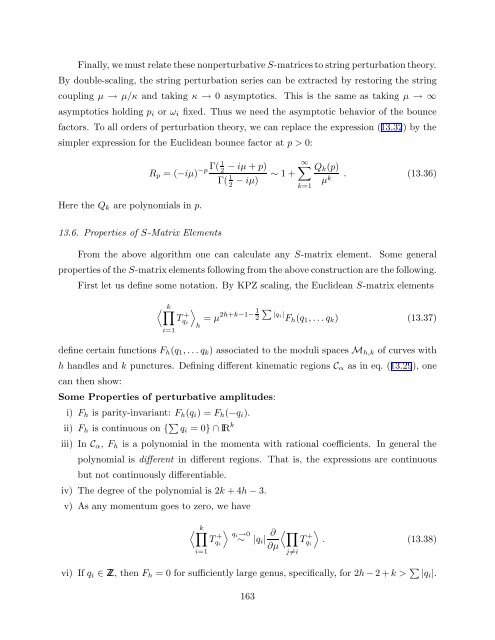arXiv:hep-th/9304011 v1 Apr 5 1993
arXiv:hep-th/9304011 v1 Apr 5 1993
arXiv:hep-th/9304011 v1 Apr 5 1993
Create successful ePaper yourself
Turn your PDF publications into a flip-book with our unique Google optimized e-Paper software.
Finally, we must relate <strong>th</strong>ese nonperturbative S-matrices to string perturbation <strong>th</strong>eory.<br />
By double-scaling, <strong>th</strong>e string perturbation series can be extracted by restoring <strong>th</strong>e string<br />
coupling µ → µ/κ and taking κ → 0 asymptotics. This is <strong>th</strong>e same as taking µ → ∞<br />
asymptotics holding p i or ω i fixed. Thus we need <strong>th</strong>e asymptotic behavior of <strong>th</strong>e bounce<br />
factors. To all orders of perturbation <strong>th</strong>eory, we can replace <strong>th</strong>e expression (13.32) by <strong>th</strong>e<br />
simpler expression for <strong>th</strong>e Euclidean bounce factor at p > 0:<br />
Here <strong>th</strong>e Q k are polynomials in p.<br />
R p = (−iµ) −p Γ( 1 2<br />
− iµ + p)<br />
Γ( 1 2 − iµ) ∼ 1 +<br />
∞∑<br />
k=1<br />
Q k (p)<br />
µ k . (13.36)<br />
13.6. Properties of S-Matrix Elements<br />
From <strong>th</strong>e above algori<strong>th</strong>m one can calculate any S-matrix element. Some general<br />
properties of <strong>th</strong>e S-matrix elements following from <strong>th</strong>e above construction are <strong>th</strong>e following.<br />
First let us define some notation. By KPZ scaling, <strong>th</strong>e Euclidean S-matrix elements<br />
〈 k∏ 〉<br />
T q + i<br />
i=1<br />
h<br />
= µ 2h+k−1− 1 2<br />
∑<br />
|qi | F h (q 1 , . . . q k ) (13.37)<br />
define certain functions F h (q 1 , . . . q k ) associated to <strong>th</strong>e moduli spaces M h,k of curves wi<strong>th</strong><br />
h handles and k punctures. Defining different kinematic regions C α as in eq. (13.29), one<br />
can <strong>th</strong>en show:<br />
Some Properties of perturbative amplitudes:<br />
i) F h is parity-invariant: F h (q i ) = F h (−q i ).<br />
ii) F h is continuous on { ∑ q i = 0} ∩ IR k<br />
iii) In C α , F h is a polynomial in <strong>th</strong>e momenta wi<strong>th</strong> rational coefficients. In general <strong>th</strong>e<br />
polynomial is different in different regions. That is, <strong>th</strong>e expressions are continuous<br />
but not continuously differentiable.<br />
iv) The degree of <strong>th</strong>e polynomial is 2k + 4h − 3.<br />
v) As any momentum goes to zero, we have<br />
〈 k∏<br />
i=1<br />
T + q i<br />
〉<br />
qi →0<br />
∼<br />
|q i | ∂ 〈∏<br />
∂µ<br />
j≠i<br />
T + q i<br />
〉<br />
. (13.38)<br />
vi) If q i ∈ Z, <strong>th</strong>en F h = 0 for sufficiently large genus, specifically, for 2h − 2 + k > ∑ |q i |.<br />
163
















